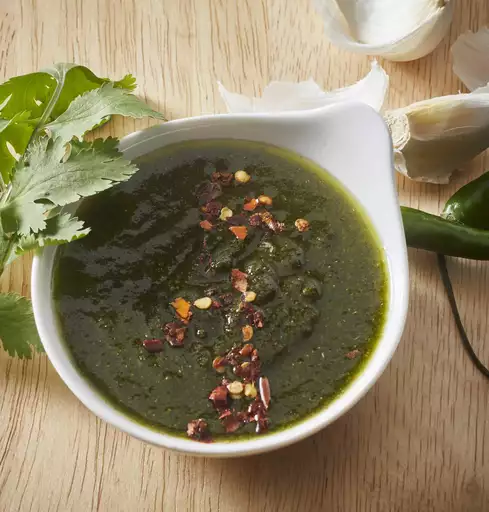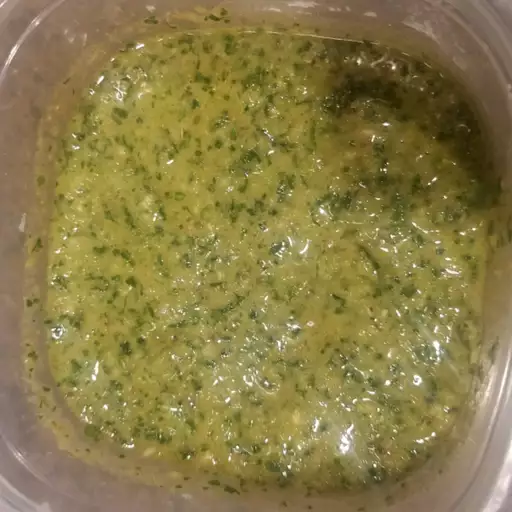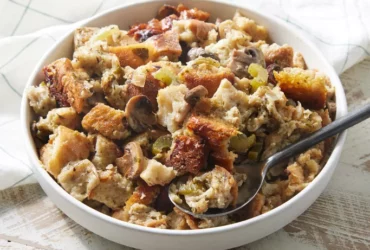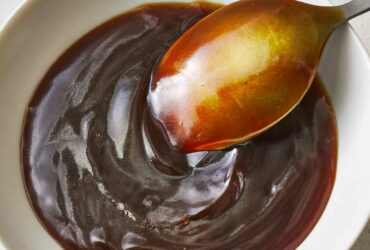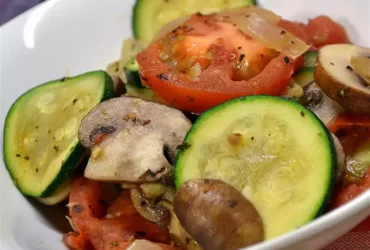What is Green Harissa?
A Spicy North African Condiment
Green harissa, also known as harissa verte or green chili paste, is a spicy and aromatic condiment originating from North Africa.
Its name, “harissa,” comes from the Arabic word for “chili pepper,” which reflects its primary ingredient – a blend of hot and sweet peppers.
The addition of green ingredients, such as parsley, cilantro, or basil, gives green harissa its distinctive color and flavor profile compared to the more well-known red harissa variant.
Traditionally, green harissa is made with a combination of ingredients like roasted green chilies, garlic, coriander, caraway seeds, and olive oil, which are blended together to create a smooth paste.
The peppers used in green harissa can vary depending on the region or personal preference, but common types include jalapeño, serrano, or Anaheim peppers, among others.
Green harissa is often associated with Tunisian and Moroccan cuisines, where it’s commonly used as a condiment to add heat and flavor to various dishes, such as stews, tagines, couscous, grilled meats, and vegetables.
The spicy kick of green harissa pairs well with rich flavors like lamb, chicken, or eggs, while its herbaceous notes complement more delicate ingredients like fish or vegetables.
In North African cuisine, green harissa is often used as a marinade for meats before grilling or baking, helping to infuse them with the complex flavors and aromas of the condiment.
Green harissa also makes an excellent addition to soups, salads, sandwiches, and dips, where it can add a boost of heat and freshness.
In modern adaptations of traditional recipes, green harissa is sometimes combined with other ingredients like yogurt or cream to create a creamy sauce for dishes like stews or curries.
Sourced from Tunisia and other parts of Africa, green harissa is a vibrant condiment made with roasted hot peppers, garlic, coriander, caraway, cumin, olive oil, and lemon juice.
Green harissa is a vibrant and flavorful condiment originating from Tunisia and other parts of Africa, made with an assortment of aromatic spices and ingredients.
The distinctive green color of this condiment comes from the roasted hot peppers that are used as its base, which gives it a slightly sweet and smoky taste. Garlic adds depth to the flavor, while coriander, caraway, cumin, olive oil, and lemon juice all contribute to create an authentic African flavor profile.
This complex combination of flavors makes green harissa a versatile condiment that can be used in various dishes, from traditional North African stews and couscous-based meals to modern fusion cuisine. It adds a spicy kick while providing a rich aromatic experience that enhances the overall taste of any dish.
One of the best things about green harissa is its ability to add heat without overpowering other flavors in a dish, making it a great addition to both vegetarian and meat-based meals. Whether you’re looking for a new way to spice up your cooking or want to try something authentic from Africa, green harissa is definitely worth trying.
For those interested in trying their hand at making green harissa at home, there are many recipes available that use fresh ingredients and simple preparation methods. With its vibrant color and bold flavors, this condiment makes for a great addition to any kitchen pantry or dining table, offering endless possibilities for culinary exploration and creativity.
Overall, green harissa is an exciting and aromatic condiment with deep roots in African cuisine that deserves to be explored and appreciated by food enthusiasts around the world. Its unique blend of spices and roasted hot peppers creates a truly unforgettable taste experience, making it a standout ingredient in both traditional and modern cooking.
Preparing the Ingredients
The Key to a Good Harissa
The foundation of an exceptional Green Harissa lies not only in the proportions of ingredients but also in the meticulous selection and preparation of each component, setting the stage for a harmonious balance of flavors.
Start by selecting the finest quality fresh or dried green chilies, such as Anaheim, Poblano, or Cubanelle. Ensure they are firm, glossy, and free from signs of wilting or decay. If using fresh, wash them thoroughly under cold running water to remove any dirt or debris.
Next, choose aromatic ingredients that will complement the heat and depth of the chilies. For a traditional North African flavor profile, include garlic cloves for their pungency, coriander seeds for a warm earthy taste, cumin seeds for their slightly bitter undertones, and caraway seeds for an added nuance.
The freshness and quality of garlic can significantly impact the overall character of your Harissa. Select plump, firm bulbs with tightly closed papery skin, as these indicate better flavor potential.
Coriander seeds add a citrusy and earthy flavor to the sauce; choose whole seeds that are light brown in color with an enticing aroma, indicating their freshness. Cumin seeds contribute a distinct warm and slightly bitter taste; select whole seeds with a slightly earthy or herbal scent for optimal results.
Caraway seeds provide a delicate anise-like flavor; use only fresh, fragrant seeds to avoid bitterness. Both cumin and coriander seeds can be toasted lightly in a dry pan until fragrant to bring out their full potential before grinding them into powder.
Cumin and coriander powder can be made by blending the seeds or purchased as pre-ground spices from reputable sources. For a more authentic flavor, toast and grind the seeds yourself for an aromatic experience.
Red pepper flakes add the signature heat to Green Harissa. Choose high-quality flakes that are fragrant with no signs of oxidation; these contribute to the vibrant red color and intense flavor of your sauce.
Finally, incorporate the necessary acidity and sweetness through lemon juice and honey or sugar. For a tangy taste balance the sweet and sour elements carefully: use fresh lemons for their zestiness and natural sugars from honey or unrefined sugar to add depth without overpowering the other flavors.
Once your ingredients are prepared, it’s time to begin crafting your Green Harissa with the perfect combination of heat, flavor, and aroma. The careful selection and preparation of each component set the stage for an exquisite culinary experience that showcases the beauty of North African flavors.
Remember, the art of preparing the ingredients is key to creating a delicious Green Harissa that will satisfy your taste buds and transport you on a flavorful journey through Morocco’s rich heritage.
Pick out some red jalapeno or other hot peppers with seeds. You can use either fresh or dried peppers for this recipe.
Selecting the right ingredients is crucial to creating a flavorful and authentic green harissa. For this recipe, we will be focusing on the preparation of red jalapeno or other hot peppers with seeds. These peppers are essential in adding heat and depth to the sauce.
Choose either fresh or dried peppers for this recipe. Fresh peppers provide a vibrant flavor and texture that is ideal for sauces, while dried peppers offer a more intense and concentrated flavor.
If using fresh red jalapeno peppers, select ones that are firm and have no signs of wilting. They should be bright red in color with a glossy appearance. You will need 4-6 fresh peppers, depending on their size and your desired level of heat.
For dried red jalapeno peppers, you can use either whole or crushed peppers. If using whole peppers, rehydrate them by soaking them in water for about 20 minutes. This will help to revive the pepper’s flavor and texture.
Once you have your peppers prepared, remove the seeds and membranes if desired. The seeds and membranes contain most of the pepper’s heat and can make the sauce too spicy. However, leaving some or all of the seeds and membranes intact will add more depth and heat to the harissa.
Cut the prepared peppers into small pieces or chop them in a food processor until you reach your desired consistency. You want the peppers to be finely chopped, but not so fine that they become paste-like.
The flavor of green harissa is enhanced when the ingredients are roasted, so roast your garlic and peppers in a dry skillet before mincing them.
To start preparing the ingredients for the green harissa recipe, it’s essential to roast the garlic and peppers in a dry skillet. Roasting brings out the natural sweetness in the ingredients, which complements the spicy heat of the dish perfectly.
Begin by placing the whole garlic cloves and peppers on a baking sheet or directly in the skillet. If you prefer a more intense flavor, use 2-3 heads of garlic and a variety of peppers such as bell, jalapeño, or Anaheim. Roasting will mellow out the sharpness of the garlic, making it sweeter and nutty.
Roast the ingredients over medium heat for about 10-15 minutes, turning occasionally to ensure even browning. The skins may start to blister and char, but this is a normal process that contributes to their rich flavor.
Once the peppers have softened and the garlic has turned golden brown, remove them from the skillet or baking sheet. Let them cool slightly before peeling off the skin and mincing the flesh.
Next, prepare your herbs by finely chopping the parsley, cilantro, and dill. The freshness of these green ingredients will help cut through the richness of the harissa and add depth to its flavor profile.
Mince the remaining ingredients such as ginger, lemon juice, olive oil, salt, and sugar according to your preference. Some people like their harissa smooth and creamy, while others prefer a chunkier texture.
Remember that roasting the garlic and peppers is an optional step in traditional green harissa recipes, but it makes a world of difference in terms of flavor and aroma. The roasted ingredients will be the base of your harissa’s flavor profile, so take the time to roast them well and enjoy the rewards!
Combining and Seasoning
Mixing to Perfection
The art of combining and seasoning ingredients lies at the heart of creating a truly exceptional dish, such as our signature Green Harissa recipe.
To begin with, let’s explore the concept of combining ingredients, which involves bringing together various components in harmony to achieve a balanced flavor profile.
Combining Ingredients
- Choose a base ingredient: In this case, our Green Harissa recipe starts with the fresh flavors of parsley, cilantro, and green chili peppers.
- Select complementary ingredients: We add aromatics like garlic, ginger, and shallots to create depth and warmth in the harissa.
- Balance flavors with acidic and sweet notes: A squeeze of fresh lime juice and a hint of honey help round out the flavor profile.
Mixing to Perfection
The art of mixing is crucial in combining ingredients, as it enables us to create a uniform texture and balance the flavors. Here’s how we achieve mixing perfection:
- Blend in small batches: Divide your ingredients into smaller batches to avoid over-processing and preserve the delicate textures of the herbs.
- Use the right tools: Invest in a high-quality blender or food processor that can handle the task at hand. A dull blade or inadequate tool will only lead to frustration and a subpar final product.
- Aim for a smooth consistency: Blend until your harissa reaches the desired consistency, taking care not to over-blend and risk developing a bitter flavor.
When it comes to seasoning, remember that less is often more. Taste as you go and adjust the flavors accordingly, rather than relying on preconceived notions or recipes.
Combine the roasted peppers, garlic, coriander, caraway seeds, cumin, salt, olive oil, and lemon juice in a food processor or blender.
The next step in preparing the Green Harissa recipe involves combining and seasoning the ingredients to create a harmonious balance of flavors.
To begin, let’s focus on the task at hand: combining the roasted peppers, garlic, coriander, caraway seeds, cumin, salt, olive oil, and lemon juice in a food processor or blender.
Step-by-Step Instructions
Add the roasted peppers to the food processor first. This will allow them to break down easily and evenly distribute their flavor throughout the mixture.
Next, add the garlic cloves and process until they are well combined with the peppers. Be careful not to overprocess at this stage, as you want to maintain some texture in your harissa.
Now it’s time to add the coriander seeds and caraway seeds. These spices will add a warm, earthy flavor to your harissa, so make sure to process them until they are fully incorporated into the mixture.
Add the cumin powder next, processing until it is well combined with the other ingredients. Cumin adds a deep, slightly bitter flavor that complements the spices and peppers beautifully.
Season your harissa with salt to taste. Start with a small amount and adjust to your liking, as you can always add more salt but it’s harder to remove excess salt from the mixture.
Pour in the olive oil, which will help to emulsify the mixture and give it a rich, creamy texture. Process until the oil is fully incorporated and the harissa has reached your desired consistency.
Finally, add the lemon juice and process until well combined. The acidity of the lemon will cut through the richness of the olive oil and add brightness to the flavor of your harissa.
Once you’ve completed these steps, transfer your Green Harissa to a serving bowl or jar and refrigerate for at least 30 minutes before using it as a condiment. This will allow the flavors to meld together and intensify, making your harissa even more delicious!
Blend the mixture until you have a smooth paste with a vibrant green color. This will make about one cup of harissa.
To combine and season the ingredients, start by blending them together in a food processor or blender until you achieve a smooth paste.
The key to making great harissa is to have the right balance of flavors, so be sure to taste as you go and adjust the seasoning accordingly.
Here are some general guidelines for combining and seasoning your green harissa:
- Add the roasted peppers, garlic cloves, coriander seeds, cumin seeds, salt, black pepper, and red pepper flakes to the food processor.
- Blend on high speed for about 30 seconds, or until the mixture starts to break down and come together as a paste.
- Add the olive oil, lemon juice, and chopped fresh parsley or cilantro to the food processor.
- Continue blending on high speed for another minute or two, or until the mixture is smooth and vibrant green in color.
This should result in a slightly thickened paste with a beautiful emerald hue. You can adjust the consistency by adding a little more oil if you prefer a thinner harissa.
Taste your green harissa and add any additional seasonings as needed – some people like to add a bit of honey or sugar for balance, while others might want to add more cumin or coriander for depth of flavor.
Once you’re happy with the taste and texture, transfer your green harissa to an airtight container and refrigerate it overnight before using it in recipes. Enjoy!
- Best Datanyze Alternatives for 2025 - April 24, 2025
- Best Hunter.io Alternatives for 2025 - April 22, 2025
- Best Lead411 Alternatives for 2025 - April 22, 2025

